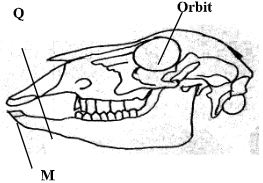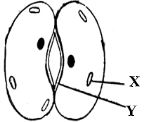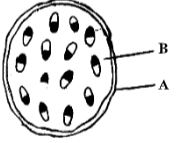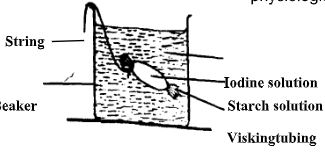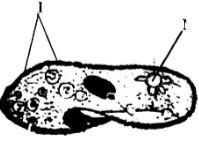INSTRUCTIONS TO CANDIDATES
- Answer all the questions
- Name the causative agents of the following diseases in humans.
- Typhoid. (1mk)
- Amoebic dysentery. (1mk)
- State the function of the following cell organelles.
- Ribosome. (1mk)
- Lysosomes (1mk)
- Nucleolus. (1mk)
-
- Name one defect of the circulatory system in humans. (1mk)
- State three functions of blood other than transport. (3mks)
-
- Distinguish between epigeal and hypogeal germination in plants. (2mks)
- Name the gland that secretes the following hormones. (2mks)
- Ecdysone
- Juvenile
-
- Give two sex linked genes found on the Y-chromosome. (2mks)
- Below is a nucleotide strand
A A G T C - Identify the type of nucleic acid. (1mk)
- Give a reason for your answer in (a) above. (1mk)
-
- Distinguish between homologous and analogous structures. (2mks)
- Give one reason why organisms become resistant to drugs. (1mk)
- The following specimen was extracted from a newly discovered organism.
- Name the tooth labeled M. (1mk)
- Name the part labeled Q and state its role. (2mks)
- The diagram below represents a cell organelle
- Name the part labeled Y. (1mk)
- State the function of the part labeled X. (1mk)
- Explain how dark stage of photosynthesis is dependent on the light stage. (2mks)
-
- Name two gaseous exchange surfaces in plants. (2mks)
- What is the importance counter current flow system in fish? (2mks)
- Form three students wanted to estimate the population in 5km2 grass field near a school compound. They captured 36 grass hoppers and marked them before returning them to the field. After a few days they made another catch of grasshoppers. They collected 45 grasshoppers out of which only 4 had marks.
- Name the method of population estimation the students used. (1mk)
- State two assumptions that were made by the students during the study. (2mks)
- From the data, calculate the population size of grasshopper. (2mks)
- State the functions of the following parts. (2mks)
-
- Endometrium
- Epididymis
- What mechanism facilities the movement of the ovum towards uterus. (1mk)
-
- The diagram below represents the flow of energy in a food chain.
Sun → Grass → Antelope → Leopard → Bacteria → P- Suggest a reason why the energy labeled P does not enter food chain (1mk)
- State one way in which energy is lost from the food chain. (1mk)
- The diagram below represents the cross section of a part of a certain plant.
- Name the class of the plant from which the section was taken. (1mk)
- Give a reason for your answer in a) above. (1mk)
- Name the parts labeled A and B. (2mks)
- State two reasons why the study of biology is important. (2mks)
- State the economic importance of the following plants excretory procedures. (3mks)
- Caffeine
- Quinine
- Colchicine
- Define the following terms
- Irritability (1mk)
- Stimulus (1mk)
- A process that occurs in plants is represented by the equation below
C6H12O6 → 2C2H5OH + CO2 + Energy- Name the process. (1mk)
- State the importance of the process named in a) above. (2mks)
-
- What is Binomial Nomenclature? (1mk)
- State two rules that are followed when printing scientific names. (2mks)
- Name three strengthening tissues in dicolyledonous plants. (3mks)
- Name the site for gaseous exchange in insects. (1mk)
-
- What is alternation of generations (2mks)
- Explain why leaves of Peridophytes are referred to as Fronds. (1mk)
- State four adaptations of red blood cells to its functions. (4mks)
- The experiment illustrated below was set up to investigate a certain physiological process
- Name the physiological process that was being investigated. (1mk)
- State the observations that were made after at the end of the experiment
- Inside the Visking tubing (1mk)
- Outside the Visking tubing (1mk)
- Account for the observations in b) above. (2mks)
- State the differences between the following structures in wind and insect pollinated flowers. (3mks)
- Anther
- Pollen grains
- Stigma
- A student placed a drop of pond water in a cavity slide and observed it under the microscope. The student observed many fast moving organisms, one of which is represented in the diagram below.
- Name the kingdom to which the organism belongs. (1mk)
- Name the structures labeled P and N (2mks)
- A person was found to pass out large volumes of dilute urine frequently. Name the;
- Disease the person was suffering from (1mk)
- Hormone that was deficient (1mk)

MARKING SCHEME
-
-
- Salmonellatyphi
- Entamoeba histolytica
Rej/f rule of binomial nomenclature not followed
-
-
- Site for protein synthesis;
- Destroys worn out organelles;
- Synthesis of ribosomes;
-
- Haemophilia; anaemia
-
- Fight disease causing organisms (Defence)
- Blood clotting
- Distribution of heat
-
-
- Epigeal
- A type of germination where by the cotyledons are brought above the soil surface.
- Hypogeal
- A type of germination where by the cotyledons remain underground
- Epigeal
-
- Prothoracic gland;
- Corpora allata;
-
-
-
- Tuft of hair on nose and ear;
- Premature baldness
Rej porcupine man
-
- DNA/Deoxyribonucleic acid
- Presence of thymine base;
-
-
- Homologous structures- structures in organisms having same embryonic origin but performing different function
-
- Mutation produces mutants that are resistant to drugs.
- Produce lytic enzymes that breakdown drugs.
-
- Canine
- Name: Diastema
Role: to pull through more plant material as they continue chewing.
-
- Stomata
- Contain chlorophyll pigment that traps light energy for photosynthesis;
-
- Requires ATP; from light stage
- Requires Hydrogen Ions; (H+) (OWTTE)
-
-
- Stomata; Epidermis; (young plants)
- Lenticels; Aerenchymatisues;
- Pneumatophores;
- Cuticle (first 2 only)
- Creates a steep concentration gradient; for maximum gaseous exchange;
-
-
- Capture-recapture;
-
- Enough time allowed for grasshoppers to randomly mix;
- The marking does not affect the animals behavior;
- No migration or immigration;
- Population = First capture x second capture
Marked recapture
= 36 X 45;
4
= 405 grasshoppers
-
-
- Site for implantation;
- Storage of sperms
-
- Contraction and relaxation of smooth muscles of walls of fallopian tube;
- Cilia waft the ovum towards the uterus.
-
-
- The energy is lost through radiation into the atmosphere
- Some of the energy is absorbed by land and water surfaces
-
- Monocotyledon
- Vascular bundles are scattered in the cortex
-
- A-Epidermis
- B -Phloem
-
- Cared subject
- Solving environmental problems
- Acquisition of Scientific skills
- Research tool/international cooperation
-
- Mild stimulant
- Treatment of malaria Rej antibiotic
- Plant and animal breeding
-
- Ability of an organism to detect/perceive and respond appropriately to a stimulus
- A change in an environment factor.
-
- Alcoholic fermentation/anaerobic respiration;
-
- Used in Beer/wine/alcoholic beverage industry;
- Used in Bread Baking
- Making of composed manure
- Production of Biogas (Mark any two correct answers)
-
- Scientific system of giving two names (Genus and species name) to an organism;
Acc Rule of double naming of organism. -
- Genus name must be in small letters;
- The names should be (printed) in italics;
- Scientific system of giving two names (Genus and species name) to an organism;
-
- Sclerenchyma;
- Collenchyma;
- Xylem (tissues) (Acc xylem vessels and iracheds)
- Tracheoles; rej Tracheal
-
- Where a plant goes through two generations sporophyte (spore producing stage) and gametophyte (gamete producing stage) stage to complete its life cycle;
- They perform both photosynthetic and reproductive functions;
-
- Biconcave in shape to increase the surface area for gaseous exchange;
- Absence of nucleus to create more space for packing of haemoglobin;
- Thin membrane for rapid diffusion of gases;
- Presence of carbonic Anhydrase for loading of Carbon (IV)
- Presence of Haemoglobine that has a high affinity for oxygen;
- Flexible/pliable to squeeze through the narrow blood capillaries (mark 1st 2)
-
- Diffusion
-
- Blue black colour observed
- Brown/yellow colour Iodine/Acccolour of Iodine Persist;
-
- Iodine molecules being smaller diffuse from the beaker to the Visking tubing;
- Starch molecules being too large do not diffuse out of the Visking tubing into the beaker;
-
Wind Pollination Insect Pollination i) Anther hang outside the flower Found inside the flower ii) Pollen grains small/light/smooth Large/hairy/heavy ii) Stigma large and feathering Small and sticky -
- Protoctista;
-
- P- Cilliumrej cilia
- N- Contractile vacuole
-
- Diabetes Inspidus
- Antiduiretic Hormone/Vasopressin;
Join our whatsapp group for latest updates
Tap Here to Download for 50/-
Get on WhatsApp for 50/-
Download Biology Paper 1 Questions and Answers - ACK Diocese Mumias Joint Evaluation Mock 2022.
Tap Here to Download for 50/-
Get on WhatsApp for 50/-
Why download?
- ✔ To read offline at any time.
- ✔ To Print at your convenience
- ✔ Share Easily with Friends / Students

